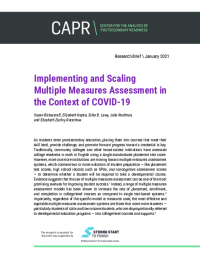Implementing and Scaling Multiple Measures Assessment in the Context of COVID-19

As students enter postsecondary education, placing them into courses that meet their skill level, provide challenge, and promote forward progress toward a credential is key. Traditionally, community colleges and other broad-access institutions have assessed college readiness in math or English using a single standardized placement test score. However, more and more institutions are moving toward multiple measures assessment systems, which combine two or more indicators of student preparation—like placement test scores, high school records such as GPAs, and noncognitive assessment scores—to determine whether a student will be required to take a developmental course. Evidence suggests that the use of multiple measures assessment can be one of the most promising avenues for improving student success. Indeed, a range of multiple measures assessment models has been shown to increase the rate of placement, enrollment, and completion in college-level courses as compared to single test-based systems. Importantly, regardless of the specific model or measures used, the most effective and equitable multiple measures assessment systems are those that move more students—particularly students of color and low-income students, who are disproportionally referred to developmental education programs—into college-level courses and supports.
State systems have played an increasingly prominent role in encouraging and supporting colleges to implement effective developmental education reforms, and more have begun to recommend or require multiple measures assessment for placement. Implementing multiple measures assessment presents challenges, including garnering buy-in for granting more students access to college-level courses, collecting and using institutional data to make decisions on the most effective and equitable process for determining placement, and marshaling the resources to redesign placement practices and train staff accordingly. Enacting these changes in a resource-constrained environment in which institutions are tasked with an ever-growing number of student success initiatives presents an additional challenge. State systems can mitigate these challenges and promote effective practices by adopting strategic policies and providing supports to colleges.
Perhaps counterintuitively, the onset of COVID-19 created opportunities for state systems to facilitate institutional adoption of multiple measures assessment. In spring 2020, as large numbers of colleges moved to remote learning and work, it was often infeasible to continue offering in-person, proctored placement tests. While institutions may have continued administering the assessments remotely, either through online remote proctoring services (e.g., Examity) or through local remote online proctoring via video conferencing services (e.g., Zoom), in many cases testing capacity was significantly reduced. As a result, institutions sought out new ways to assess and place students. Through changes to policy and re-allocation of resources, four states—Indiana, Virginia, Texas, and Washington—supported large-scale changes to placement practices. These states exemplify how systems and institutions can rapidly adapt to overcome common challenges associated with implementing multiple measures assessment. In the short case studies that follow, based on interviews with system leaders as well as college administrators, faculty, and staff, we summarize each state’s pre-COVID assessment and placement policies and practices and describe the system-level actions taken to mitigate common multiple measures assessment implementation challenges: (1) establishing buy-in, (2) providing implementation support and resources, (3) combatting initiative fatigue, and (4) establishing data-driven, continuous improvement evaluation processes.






